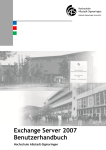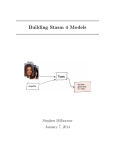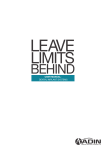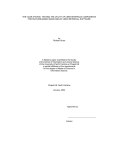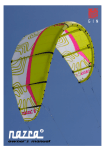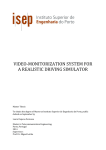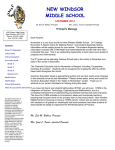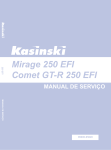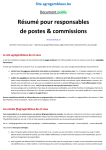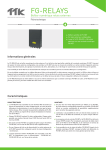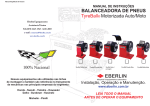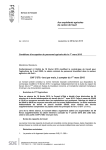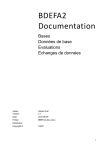Download Stasm 4 User Manual
Transcript
Stasm 4
User Manual
Stephen Milborrow
December 27, 2013
Contents
1 Introduction
1
2 Executables
2
3 Building Stasm
4
4 Stasm library functions
4.1 Simple interface . . . . . . . . .
4.2 More versatile interface . . . . .
4.3 The minwidth argument . . . .
4.4 The multiface argument . . .
4.5 Partial initialization by the user
4.6 Error handling . . . . . . . . .
4.7 Utility functions . . . . . . . . .
.
.
.
.
.
.
.
5 Visual FAQ
.
.
.
.
.
.
.
.
.
.
.
.
.
.
.
.
.
.
.
.
.
.
.
.
.
.
.
.
.
.
.
.
.
.
.
.
.
.
.
.
.
.
.
.
.
.
.
.
.
.
.
.
.
.
.
.
.
.
.
.
.
.
.
.
.
.
.
.
.
.
.
.
.
.
.
.
.
.
.
.
.
.
.
.
.
.
.
.
.
.
.
.
.
.
.
.
.
.
.
.
.
.
.
.
.
.
.
.
.
.
.
.
.
.
.
.
.
.
.
.
.
.
.
.
.
.
.
.
.
.
.
.
.
.
.
.
.
.
.
.
.
.
.
.
.
.
.
5
5
5
5
5
6
6
6
8
6 Stasm version 4 and 3
11
7 Notes on the implementation
12
8 Citing Stasm
14
9 Acknowledgments
15
A Stasm License Agreement
17
Bibliography
19
1
Introduction
Stasm is a C++ software package for locating facial landmarks in faces. You give it a
face image and it returns the positions of the landmarks (Figure 1).
Stasm is designed to work on front views of more-or-less upright faces with neutral
expressions. You will see poor fits on faces at angles or with expressions. Download the
self-installing Windows program wasm.exe to see what Stasm can do. It has performed
well in comparative studies [3].
Stasm uses the OpenCV library and is released under a BSD style license (Appendix A).
The Histogram Array Transform (HAT) descriptors used by Stasm for template matching are similar to SIFT descriptors [9]. Since the SIFT algorithm is patented, this
potentially opens a patent issue for commercial use. (I’m not qualified to say if it
does.) Section 7 has some technical details.
If you are interested in training new models, please see Building Stasm 4 Models [11],
downloadable from the Stasm website.
1
Figure 1: The 77 Stasm landmarks and their numbers.
Note that Stasm versions prior to version 4.0.0 had a different license (GPL).
2
Executables
The following example programs are provided with the package.
minimal
Minimal program using the stasm search single function (Figure 2). This reads an
image and show the face landmarks in an OpenCV popup window.
minimal2
Like the minimal program above but uses the stasm search auto function, which
allows you to locate landmarks in multiple faces in an image.
wasm
Windows utility for demonstrating Stasm. You can scroll through all images in a
directory with the PgUp and PgDn keys. Face widths must be at least 25% of the image
width.
stasm
2
// minimal.cpp: Display the landmarks of a face in an image.
//
This demonstrates stasm_search_single.
#include
#include
#include
#include
<stdio.h>
<stdlib.h>
"opencv/highgui.h"
"stasm_lib.h"
int main()
{
static const char* path = "../data/testface.jpg";
cv::Mat_<unsigned char> img(cv::imread(path, CV_LOAD_IMAGE_GRAYSCALE));
if (!img.data)
{
printf("Cannot load %s\n", path);
exit(1);
}
int foundface;
float landmarks[2 * stasm_NLANDMARKS]; // x,y coords
if (!stasm_search_single(&foundface, landmarks,
(char*)img.data, img.cols, img.rows, path, "../data"))
{
printf("Error in stasm_search_single: %s\n", stasm_lasterr());
exit(1);
}
if (!foundface)
printf("No face found in %s\n", path);
else
{
// draw the landmarks on the image as white dots
stasm_force_points_into_image(landmarks, img.cols, img.rows);
for (int i = 0; i < stasm_NLANDMARKS; i++)
img(cvRound(landmarks[i*2+1]), cvRound(landmarks[i*2])) = 255;
}
cv::imshow("stasm minimal", img);
cv::waitKey();
return 0;
}
Figure 2: Example program to read an image and display the facial landmarks.
Command line utility to locate face landmarks in one or more images. Output goes to
the text file stasm.log. You can set the minimum face size and so on with command
line flags. You can tell it to list the landmarks in Stasm’s default 77 point format,
or in the XM2VTS [10], BioID [7], AR [16], or me17 [5] formats, or in the 76 point
format used in old versions of Stasm. You can tell it to list the landmarks as a Stasm
“shapefile” or as comma separated values.
swas
Command line utility to compare landmarks automatically located to reference land-
3
marks. (Swas stands for “Stasm with a shapefile”.) Swas creates a text file that lists,
for each face, the mean fitness (mean distance between found landmarks and reference
landmarks, divided by the reference inter-pupil distance), the me17 fitness (mean fitness over 17 points [5]), and the FM29 fitness (an anisotropically weighted sum of 29
landmarks used for internal development).
test stasm lib and test stasm lib err
Utilities for testing the package in conjunction with the stasm/tests directory. See
the makefiles for details.
3
Building Stasm
Building Stasm is straightforward. You first need to install OpenCV. Stasm has been
tested on OpenCV versions 2.3.1 and 2.4.0, but the version probably isn’t important.
Use the following configuration to build the minimal example program (the paths below
assume your working directory is say stasm/work):
Source files:
../apps/minimal.cpp
../stasm/*.cpp
../stasm/MOD_1/*.cpp
contains main()
Stasm library files
frontal pose models
Include path:
../stasm
OPENCV_HOME/build/include
dir for stasm.h etc.
dir for opencv/cv.h etc.
OpenCV libraries needed:
core imgproc objdetect
highgui
for Stasm library
for apps that use imwrite etc.
For details see the make files included with the package. You will need to tweak the
make files for the location of your OpenCV directory.
In Windows environments, batch files are also provided for building minimal.exe and
a few other utilities. Microsoft Solution files are provided for building minimal.exe in
the Visual Studio IDE. Caveat: the Solution files were created by someone who seldom
uses the IDE (precompiled headers aren’t enabled, for instance).
If this is your first OpenCV project, we recommend that you first check your setup
independently of Stasm by building and running a simple OpenCV program. This
holds especially in a Windows environment, where the error messages for missing or
mismatched DLLs can be very misleading.
Juan Cardelino has provided cmake files for Linux and other systems. See the Stasm
web page.
4
4
Stasm library functions
The library interface is defined stasm lib.h. The landmark names listed in
stasm landmarks.h are sometimes also useful.
4.1
Simple interface
The simplest approach is to invoke the function stasm search single (Figure 2). This
finds the largest face in the image (using the OpenCV frontal face detector) and returns
the positions of the landmarks. The face width must be at least 10% of the image width.
If your image is color, convert it to monochrome before passing it to Stasm. In OpenCV
you can use cvtColor(colorimage, monoimage, CV BGR2GRAY).
4.2
More versatile interface
The library also provides a more versatile interface for software that needs to locate
the landmarks in multiple faces in an image or to fine tune the interface. The basic
idea is that you call stasm open image to detect the face(s), and then repeatedly call
stasm search auto to landmark the faces, one by one. For details see minimal2.cpp
and the comments in stasm lib.h
4.3
The minwidth argument
The minwidth argument of stasm open image specifies the minimum face detector box
width as a percentage of the image width. It helps reduce false face detections (on the
scenery behind the subject for instance). Typical values are 10% or 25%. After scaling
by the image width, it is passed to the OpenCV function detectMultiScale.
4.4
The multiface argument
If you set the multiface argument of stasm open image to 1, you can call
stasm search auto repeatedly until there are no more faces in the image. If you set
it to 0, stasm search auto will return the single “best” face. This will usually be the
largest face detected by the OpenCV frontal detector.
To reduce false positives, when three or more faces are detected, any face that is very
much bigger or smaller than than the median detected face is discarded internally. An
implication is that occasionally the “best” face may not be the largest face, because
the largest face has been discarded (treated as a false positive). Another implication
is that with multiface set at 1, in a group shot only faces that are roughly similar in
size will be returned. In practical applications this approach seems to work fairly well,
especially when minwidth is small. It will sometimes make mistakes. Remove the call
to DiscardMissizedFaces in facedet.cpp if you don’t want this automatic removal
5
of missized faces. When debugging, change #define TRACE IMAGES to write images
showing the raw face rectangles.
4.5
Partial initialization by the user
In some applications, the user manually pins a few points on the face and the machine
automatically places the remaining points. This process may be iterated so the user
can correct the machine-generated positions. Use stasm search pinned to implement
this.
The current implementation was trained mainly for when the user pins five specific
points: the outer corners of the eyes, the nose tip, and the corners of the mouth — but
stasm search pinned will also work if any two or more points are pinned. Note that
the face detector isn’t needed, because the ASM start shape is formed by aligning the
mean training shape to the pinned points.
4.6
Error handling
The Stasm library functions return 1 on success and 0 on error. If a function returns 0,
use stasm lasterr to get the error string. The functions never throw exceptions. An
example error is "Cannot open ../data/haarcascade frontalface alt2.xml".
CV Assert fails inside Stasm are handled in the same way. The library functions will
catch the assert internally and return 0. Use stasm lasterr as usual to get details
of the failure. (TODO CV Assert is currently not working like this in Mingw builds,
although the Stasm error function Err is working.)
Note that “not finding a face” isn’t an error in the sense we are using it here. If the
search function runs successfully but doesn’t find a face, it returns 1 for success, but
with the foundface argument set to 0.
4.7
Utility functions
A few utility functions are also provided.
stasm convert shape converts the default 77 point shape to a shape with the specified
number of points. It can convert to the XM2VTS, BioID, AR, or me17 formats, or to
the 76 point format used in old versions of Stasm. The landmark definitions often don’t
coincide exactly, particularly on the side of the forehead and jaw, and on the nostrils.
The position of these landmarks is estimated from nearby landmarks.
stasm force points into image forces landmarks into the image boundary. In normal
use, if say the forehead is cut off by the edge of the image, Stasm will position the
forehead landmarks above the image boundary.
stasm printf prints to stdout like printf but also prints to the file stasm.log, if it
is open. (It will be open if stasm init was called with trace=1.) This function was
6
added primarily for the programs that test the package, but may be otherwise useful.
7
5
Visual FAQ
In this section we show some images where Stasm performed poorly, and give a brief
explanation. (Most of the images are from the BioID set [7].)
Figure 3:
The face detector did not
find the face.
(Stasm uses the OpenCV
frontal face detector.)
Figure 4:
The face detector
the door for a face.
mistook
Figure 5:
The face detector mistook
the nostril and mouth for a
face.
8
Figure 6:
Stasm struggled
non-frontal face.
with
the
with
the
Figure 7:
Stasm struggled
non-frontal face.
Figure 8:
Stasm mistook
for the jawline.
the
collar
Figure 9:
Stasm mistook the vertical
edge of the door for the left
jawline.
9
Figure 10:
The glasses caused the face
detector to overestimate the
size of the face. The start
shape was too big, and Stasm
didn’t recover, mistaking the
chin for the mouth.
Figure 11:
Stasm was
the mustache.
confused
by
Figure 12:
Stasm does not work very
well with open mouths.
Figure 13:
Stasm mistook the bottom
of the bottom lip for the top
of the lip. Probably the face
rectangle was too big and
Stasm did not make a full
recovery.
10
6
Stasm version 4 and 3
This section describes the differences between Stasm version 4 and version 3.
Stasm 4 is released under a BSD style license; Stasm 3 was released under a GPL
license.
Stasm 4 has 77 landmarks (Figure 1); Stasm 3 has 76 landmarks.
95th percentile
90th percentile
0.8
1.0
Both Stasm 4 and 3 are designed for frontal faces, but Stasm 4 is a bit more flexible
and can handle a wider variety of faces. Figure 14 compares the me17s [5] for the two
different Stasm versions. The figure is admittedly a bit cluttered, but Stasm 4 does
better than Stasm 3. Details. The BioID [7] and PUT [8] curves include the entire
set. The DEF set is a difficult test set we use internally. The poor performance on
the right of the DEF curve is principally due to the many non-frontal faces in the set,
a challenge that requires heavier (and slower) machinery than either version of Stasm.
0.6
Stasm version 4 gives better
fits than version 3.
0.4
median
0.2
Compare the solid
the dashed lines.
lines
to
Stasm4 solid, Stasm3 dashed
PUT
BioID
DEF
0.0
0.00
0.04
0.08
0.12
Figure 15:
●
●
●
●
●
Version 4 is faster than version 3.
The graph is for VC10 32 bit builds
without OpenMP on a 3.4 GHz i7.
●
Stasm4
Stasm3
PUT 280
BioID 55
DEF 360
search time in ms
50 100 150 200 250
me17
0
proportion
Figure 14:
11
Faces not found by the OpenCV frontal detector are included in the curves, but with
me17 set to infinity. They reduce the height of the curves at the right of the plot.
Stasm 4 is faster (Figure 15). The ASM search itself is faster, and there is also less
internal overhead converting image formats and so on before starting the search.
Building Stasm 4 is easier than Stasm 3. The code has been cleaned up and simplified.
Stasm 4 supports both 64 and 32 bit builds.
Stasm 4 uses standard OpenCV image coordinates (0,0 is the top left of the image);
Stasm 3 uses an internal coordinate system where 0,0 is the center of the image.
Stasm version 4 uses the OpenCV libraries throughout — which makes operations like
image scaling trivial, using functions familiar to OpenCV users. Stasm 3 has its own
routines for image scaling, reading images, etc.
In Stasm 3 the models are read off disk during runtime initialization. In Stasm 4 the
models are built-in (meaning that C++ model files were created during model training,
and these files get compiled into Stasm). Thus the only external files needed by Stasm 4
are the OpenCV face and feature detection files (haarcascade frontalface alt2.xml
and friends). A benefit is that Stasm 4 starts up more quickly.
7
Notes on the implementation
The OpenCV frontal face detector often fails if the face is near the edge of the image.
To counteract this, Stasm internally adds a 10% border around each edge of the image
(Figure 16). Change BORDER FRAC to 0 in facedet.cpp if you don’t want the border
(it makes face detection slower, 1.2 x 1.2 = 44% more image area, or maybe you want
to exclude cut-off faces).
Stasm can use OpenMP if your compiler supports it. (On multicore machines, Stasm
Figure 16: left Face is too near the edge — face detection fails.
right Artificial border added — face is now detected.
Face detect failrate on the BioID set goes from 3.3% down to 0.7%.
12
uses OpenMP for template matching on several landmarks in parallel.) Enable OpenMP
with the OpenMP command line flag for your compiler (typically -openmp or -fopenmp).
In our experience OpenMP can sometimes offer significant speed advantages, although
these may depend on the compiler in non obvious ways.
A hash map is used in hatdesc.cpp, which may cause some portability issues. You can
easily disable references to hash map by changing a #define, although that will make
Stasm slower.
Stasm is based on the Active Shape Model (ASM) developed by Cootes and Taylor [4,
14]. Stasm uses Histogram Array Transform (HAT) descriptors for template matching
at landmarks as described in [15].
Here is an overview of HAT descriptors. Like SIFT descriptors [9], HATs are grids of
image orientation histograms, with orientations weighted by the gradient magnitude
and smoothed out over nearby histogram bins. Stasm prescales the face to a fixed eyemouth distance of 100 pixels and rotates the face so the eyes are horizontal. Thus the
extreme scale invariance of SIFT isn’t required, nor is the SIFT descriptor’s automatic
orientation to the local average gradient direction. In that sense HAT histograms are
more similar to earlier descriptors such as those in [1, 6]. For readers familiar with
SIFT, note that ASMs like Stasm employ descriptors very differently from SIFT. SIFT
discovers and matches image-defined keypoints at sparse scale space extrema; the ASM
moves the descriptors in a fine grid, after training on a large set of faces where the facial
landmarks were manually assigned.
The Stasm models were trained on the MUCT data [13] with landmarks extended to
77 points. The models are defined in .mh files, which are machine generated C++ files.
If you are interested in training new models, please see the manual Building Stasm 4
Models [11]. You can train models for faces, or “non-face data” such as medical images.
You will see references to three-quarter face models in the code. However the current
open-source version of Stasm uses only a frontal model (referred to as the yaw00 model
in the code). The three-quarter models (referred to as the yaw22 and yaw45 models)
may be released in the future, but for now the code for three-quarter views stays inactive
in the released code. Our approach to multiview models is described in [12].
Some variables are not thread-safe (because they are static to a function or class). For
most people this is not an issue. If it is for you, locate these by enabling the thread
safety warnings for your compiler. With the Microsoft compilers, one approach is to
use -Wall on the command line and search the compiler warnings for thread-safe.
Define TRACE IMAGES true in stasm.h for Stasm to create debugging images showing
the face detector face(s), ASM search progress, etc. The images are named so they list
in the order they were created.
Arguments that may be modified appear first in function argument lists. When the
function is invoked, such arguments are often listed on their own line. For example,
FaceRoiAndDetPar(face_roi, detpar_roi,
img, detpar, false);
indicates that face roi and detpar roi will be modified.
13
Stasm stores shapes as x0, y0, x1, y1,· · · (rather than as x0, x1,· · · , y0, y1,· · · ).
Global variables have a g suffix. These are used, for example, for saving command-line
flags, where this somewhat unstructured use of globals is clearer than passing flags
as arguments through possibly nested functions. All such variables are “file global”
(i.e. declared as static), except for print g, trace g, and imgpath g.
• The print g variable is by default false; set it true to allow output to stdout
(as well as to the log file).
• The trace g variable is also by default false; set it true to trace Stasm’s operation. Both of the variables are set by stasm init’s trace argument.
• The imgpath g variable holds the path of the current image. It is used only for
debugging and tracing (TRACE IMAGES must be set; see the above paragraph on
TRACE IMAGES).
C++ class member names have trailing underscore.
Internal code is in the stasm namespace. The library interface functions aren’t in a
name space — instead they have a stasm prefix.
Nearly all .h files are included in the single file stasm.h, to facilitate precompiled
headers to speed the build process. Definitions needed by the example applications
(but not in the Stasm library code itself) are in appmisc.h.
8
Citing Stasm
Cite Stasm as [15]:
@article{Milborrow14,
author={S. Milborrow and F. Nicolls},
title={{Active Shape Models with SIFT Descriptors and MARS}},
journal={VISAPP},
year={2014},
note={\url{http://www.milbo.users.sonic.net/stasm}}
}
Cite this user document as follows (although it’s normally best to cite the Stasm paper):
@book{StasmManual,
author={S. Milborrow},
title={Stasm User Manual},
publisher={\url{http://www.milbo.users.sonic.net/stasm }},
year={2013}
}
You may need to add \usepackage{url} to your tex file to support the \url in the
citation.
14
9
Acknowledgments
It is a pleasure to acknowledge the following people who provided ideas, code, data,
and techniques used in Stasm. The list is in alphabetical order.
Juan Cardelino for his cmake files.
M. Castrillón Santana, O. Déniz Suárez, M. Hernández Tejera, and C. Guerra
Artal at the University of Las Palmas de Gran Canaria for their OpenCV eye and
mouth detectors [2].
Tim Cootes http://www.isbe.man.ac.uk/~bim
David Cristinacce http://mimban.smb.man.ac.uk
Eugen Dedu for his line drawing code used in earlier versions of Stasm http://lifc.
univ-fcomte.fr/~dedu
M. Galassi, J. Theiler, and others for the GSL library used in earlier versions of
Stasm http://www.gnu.org/software/gsl
Rob Hess for his opensift library, helpful for getting to grips with the details of SIFT
http://blogs.oregonstate.edu/hess/code/sift
GuoQing Hu for his start-shape alignment technique and for an Android demo http:
//www.androidhat.org
O. Jesorsky, K. Kirchberg, and R. Frischholz for the BioID data http://www.
bioid.com/downloads/facedb
David Lowe the inventor of SIFT http://www.cs.ubc.ca/~lowe/home.html
The manual landmarkers at Manchester for their work http://david.cristinacce.
net and http://www.isbe.man.ac.uk/~kob
Aleix Martinez and Robert Benavente for the AR database http://cobweb.ecn.
purdue.edu/~aleix/aleix_face_DB.html
Darren Murray and his team for high quality manual landmarking
Ramin Nakisa and others for gslwrap used in earlier versions of Stasm http://
sourceforge.net/projects/gslwrap
Fred Nicolls http://www.dip.ee.uct.ac.za/~nicolls
Developers and contributors to the OpenCV library
Henry Rowley, Shumeet Baluja, and Takeo Kanade for the Rowley face and eye
detector used in earlier versions of Stasm http://vasc.ri.cmu.edu/NNFaceDetector
Oliver Walker, Elizabeth Walker-Watts, and Gill Andrew for MUCT landmarking
Roger Willcocks for his prototype ASM code http://www.rkww.com
15
Yan Wong at Bang Goes The Theory http://www.bbc.co.uk/bang
The XM2VTS people at Surrey for the XM2VTS database http://www.ee.surrey.
ac.uk/CVSSP/xm2vtsdb
Brad Yearwood and Pierre Moreels for help with the original Ubuntu port
The following people also contributed in one way or another. Thanks guys!
Anton Albajes-Eizagirre, Peter Anderson, Daniel Lelis Baggio, Christian Baumberger,
Andew Berends, Tom Bishop, Mohamed Bouras, Omar Cavagna, Sai Chaitanya, Mark
Chen, Radke Chinar, Samuel Clark, Wang Dayong, Elliott Dicus, Philippe Dreuw, Dave
Durbin, Silam Abd Elfattah, Martin Etchart, Arnaud Gelas, Allen Gordon, Moti Hamo,
Yu Hang, Paul Harper, Sean He, Bartlomiej Hyzy, T.S. Karthikeyan, Voung Le, Ryan
Lei, Tamas Lengyel, Ying Li, We-Chao Lin, Satish Lokkoju, David Daniel Macurak,
Jaesik Min, John Morkel, Ghulam Muhammad, Alka Nair, Svetoslav Nedkov, Brett
Oberman, Alexander Petrov, Sebastien Piccand, Tony Polichroniadis, Simon Prince,
Raymond Ptucha, Yiming Qian, Ham Rara, David Ricardo, Chris Ritchie, Sheerko Hma
Salah, Jason Saragih, Lakshmiprabha Nattamai Sekar, Lei Shi, Seyedehsamaneh Shojaeilangar, Gagandeep Singh, Abhi Sinha, Nirin Suarod, Yunlian Sun, Phyliss Thomas,
Andy Wang, Xuezhong Wang, Mark Williams, Jian Yao, Kotaro Yasuda, Hao Zhang,
Hao Zhou, and Tianmin Zou.
16
A
Stasm License Agreement
Stasm License Agreement
Copyright (C) 2005-2013, Stephen Milborrow
All rights reserved.
Redistribution of Stasm in source and binary forms, with or
without modification, is permitted provided that the following
conditions are met:
* Redistributions of source code must retain the above copyright notice,
this list of conditions and the following disclaimers.
* Redistributions in binary form must reproduce the above copyright notice,
this list of conditions and the following disclaimers in the documentation
and/or other materials provided with the distribution.
A SIFT patent restriction may be in conflict with the copyright
freedoms granted by this license. This license does not give you
permission to infringe patents.
This software is provided by the copyright holders and contributors "as is" and
any express or implied warranties, including, but not limited to, the implied
warranties of merchantability and fitness for a particular purpose are disclaimed.
In no event shall the copyright holder be liable for any direct,
indirect, incidental, special, exemplary, or consequential damages
(including, but not limited to, procurement of substitute goods or services;
loss of use, data, or profits; or business interruption) however caused
and on any theory of liability, whether in contract, strict liability,
or tort (including negligence or otherwise) arising in any way out of
the use of this software, even if advised of the possibility of such damage.
Note that Stasm versions prior to version 4.0.0 had a different license.
17
References
[1] S. Belongie, J. Malik, and J. Puzicha. Shape Matching and Object Recognition
Using Shape Contexts. PAMI, 2002.
[2] M. Castrillón Santana, O. Déniz Suárez, M. Hernández Tejera, and C. Guerra Artal. ENCARA2: Real-time Detection of Multiple Faces at Different Resolutions
in Video Streams. Journal of Visual Communication and Image Representation,
2007.
[3] O. Çeliktutan, S. Ulukaya, and B. Sankur. A Comparative Study of Face Landmarking Techniques. EURASIP Journal on Image and Video Processing, 2013.
http://jivp.eurasipjournals.com/content/2013/1/13/abstract. This study
used Stasm Version 3.1.
[4] T. F. Cootes and C. J. Taylor. Technical Report: Statistical Models of Appearance
for Computer Vision. The University of Manchester School of Medicine, 2004.
http://www.isbe.man.ac.uk/~bim/Models/app_models.pdf.
[5] D. Cristinacce and T. Cootes. Feature Detection and Tracking with Constrained
Local Models. BMVC, 2006. mimban.smb.man.ac.uk/publications/index.php.
[6] W. T. Freeman and M. Roth. Orientation Histograms for Hand Gesture Recognition. AFGR, 1995.
[7] O. Jesorsky, K. Kirchberg, and R. Frischholz. Robust Face Detection using the
Hausdorff Distance. AVBPA, 2001. www.bioid.com/downloads/facedb.
[8] A. Kasinski, A. Florek, and A. Schmidt. The PUT Face Database. Image Processing and Communications, 2008. https://webmail1.cie.put.poznan.pl/
biometrics/index.php.
[9] D. G. Lowe. Distinctive Image Features from Scale-Invariant Keypoints. IJCV,
2004.
[10] K. Messer, J. Matas, J. Kittler, J. Luettin, and G. Maitre. XM2VTS: The Extended M2VTS Database. AVBPA, 1999. www.ee.surrey.ac.uk/Research/VSSP/
xm2vtsdb.
[11] S. Milborrow. Building Stasm 4 Models. http://www.milbo.users.sonic.net/
stasm, 2014.
[12] S. Milborrow, Tom E. Bishop, and F. Nicolls.
Multiview Active Shape Models with SIFT Descriptors for the 300-W Face Landmark Challenge.
ICCV, 2013.
http://www.milbo.org/stasm-files/
multiview-active-shape-models-with-sift-for-300w.pdf.
[13] S. Milborrow, J. Morkel, and F. Nicolls. The MUCT Landmarked Face Database.
Pattern Recognition Association of South Africa, 2010. http://www.milbo.org/
muct.
[14] S. Milborrow and F. Nicolls.
Locating Facial Features with an Extended
Active Shape Model. ECCV, 2008. http://www.milbo.org/stasm-files/
locating-facial-features-with-an-extended-asm.pdf.
18
[15] S. Milborrow and F. Nicolls.
Active Shape Models with SIFT Descriptors and MARS.
VISAPP, 2014.
http://www.milbo.org/stasm-files/
active-shape-models-with-sift-and-mars.pdf.
[16] FGNET project. The AR Face Database 22 Points Markup. FGNET, 1998.
www-prima.inrialpes.fr/FGnet/data/05-ARFace/tarfd_markup.html.
19




















